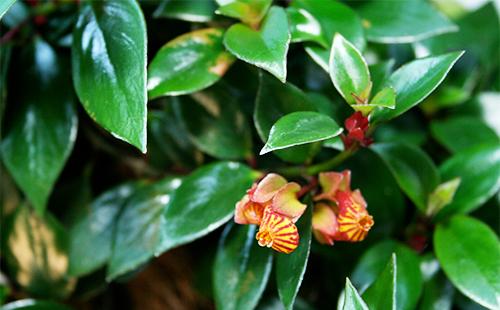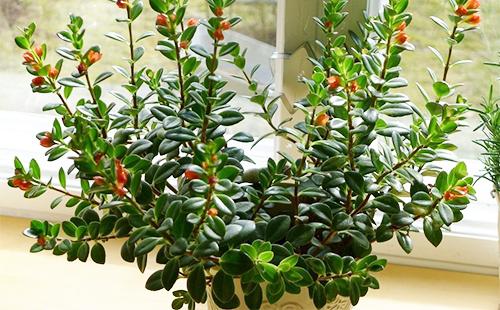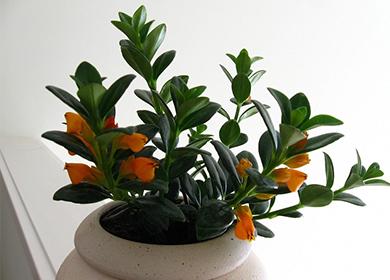The content of the article
Nematantus belongs to the Gesneriev family. It is also called hypocytosis. Most representatives of this culture are characterized by semi-epiphytic and epiphytic methods of growth. They develop well on tree branches, collapsed trunks and in other areas where there is enough moisture and loose soil.
Description and types
The goldfish flower was discovered back in 1846, but became popular among home culture lovers not so long ago. It is represented by small dark green leaves with a brilliant hue and buds in the form of small fish with a red-orange or yellow hue. The following types of culture are distinguished.
Riverine
Climbing plant. It features elliptical foliage. The length of the leaves is not more than 10 cm. The surface is shiny and green, the bottom of the foliage is slightly reddish. Lemon yellow buds are located on small pedicels.
Fritscha
The flower reaches a height of about 60 cm, elongated leaves up to 7.5 cm. Green-red color. The stalk is thin and lowered. Buds of delicate light pink color, up to 5 cm in size.
Gregarius (goldfish)
One of the popular varieties of culture. It differs in small leaves of a deep dark green hue and buds resembling the shape and color of goldfish from the aquarium. This species is divided into several subspecies, among which are the following.
- Sir. Variegate variety with thin saturated green leaves decorated with a light green border, greenish-orange flowers and buds of red-orange color.
- Golden West. It is attributed to variegated representatives and has the appearance of dense foliage with a waxy surface of a green-blue hue and the addition of cream-yellow at the edges, as well as saturated orange buds.
- Santa Teresa. A rare variety, characterized by white fluffy buds with a citrus-olive aroma.
Naked
Refers to semi-ampel plants. The leaves are dark and fleshy, with a glossy finish, elliptical in shape, up to 4 cm long. The buds are "burning" - red-orange in color, hanging from the foliage. Shoots reach 25 cm in length.
Monolithic
Belongs to ampelous plants. The leaves are fleshy, rounded in shape, light green in color, up to 2 cm long. Flowers are bright red in color with a yellowish limb. After flowering, foliage is showered in this species.
Ankle
Refers to semi-shrub epiphytes. The leaves are opposite elliptical, about 10 cm long and up to 4 cm wide. The color of the foliage is light green. Buds with a rough surface of a red shade. Presented in the form of a funnel hanging on a thin peduncle.
Vetstein
Ampel flower with thin stems that branch. Their length reaches 90 cm. The shape of the leaves is oval, they are brilliantly waxy. The color is dark green. The flowers are yellow or orange-red. Buds reach a length of up to 2.5 cm. This type of culture is characterized by good flowering.
Tropicana
An unusual appearance, the difference of which is oval-pointed leaves with a glossy surface. And also flowers of red, orange-yellow hue with golden stripes.
Basic care
Hypocirrha is an exotic plant that requires special care.
- Lighting. For full growth and flowering need bright diffused light. In summer, it is better to remove the flower from the south side and put it on the east or west. In autumn, winter and spring, southern windows are also suitable. In the cold season, additional lamp lighting is required.
- Temperature. In summer and spring, the culture has accelerated development, and room temperature indicators within 25 ° C are sufficient for it. At the time of rest, which falls in the winter, the thermometer should be within 15 ° C.
- Humidity. The culture grows well in a room with high humidity. In the spring and summer, the flower must be sprayed often.
- Watering. With the onset of heat, nematanthus should be watered well, especially in hot weather. It is also recommended to put the pot in water for ten minutes. In winter, you need to water the pet in moderation, but do not stop watering, otherwise the foliage will begin to crumble.
During flowering, you need to water and fertilize the flower well, providing it with enough light.
Soil and fertilizer
The plant feels good in a loose substrate, good air permeability. Its acidity should be weak or neutral. Suitable soil, which includes humus, any sand, a little peat, as well as sheet land. The ratio of the components is 1: 1: 1: 2. Additionally, charcoal and sphagnum moss can be added to the soil. Such soil is most similar to tropical. Mixtures for senpolia can be used.
Mineral fertilizers must be applied during the period of active growth once or twice a month. From the end of autumn to the beginning of spring, it is not necessary to feed the flower.
Pruning and transplanting
A plant transplant must be performed as it grows. The new pot should be slightly larger than the previous one. When the capacity is too large, the roots may rot. The pot must have good drainage so that water does not stagnate. It is better to transplant in the spring.
Procedure
- Take a container with large holes.
- Put the drainage layer on the bottom.
- Spread the soil without tamping hard.
- Remove the plant with an earthen lump from the old container and place in a new one.
- After the transplant, water the plant.
When extracting a flower, maximum care must be taken so as not to damage the root system. The fact that the plant needs to be transplanted will be indicated by the appearance of roots in the holes of the pot and a decrease in leaf growth.
If the flower is already many years old, it does not need to be relocated. Re-rooting is in progress. Several cuttings can be planted in one container at once.
The plant often needs to be pruned - new buds appear only on young shoots. Pruning is done in the spring, shoots grow during the winter, foliage sprinkles. Also, pruning should be done after flowering. This allows you to rejuvenate the flower and improve its flowering.

Breeding
You can do it in two ways. Suitable seeds and cuttings, which are taken from the stems and tops.
Seeds
Description. Unlike other flowers growing at home, nematanthus propagates well by seed and begins to bloom after a year.
Procedure
- After flowering, seeds are formed that need to be removed on a sheet of paper.
- Prepare moist soil and sow seeds evenly to the surface. Sprinkle with earth above.
- Cover the container with glass, which is sometimes removed to prevent debate.
- Watering through the pan.
- Seated sprouts sprouted in a pot for several pieces.
Cuttings
Description. This method is considered faster and easier. It is better to cut the blanks from ripened shoots, as thin cuttings quickly rot.
Procedure
- Cut the cuttings with a length of 8-10 cm. The lower cut of the workpiece should be at an angle, the two pairs of leaves that are located below must be removed.
- Plant the resulting blanks in sphagnum, loose peat or place in a container of water. There should be a knot in the ground, not an internode.
- After rooting, the sprouts should be sent to a common greenhouse - a small container with soil, which is covered with polyethylene.
- After two to three weeks to plant young shoots.
As a soil, a substrate for violets and a similar loose soil are suitable. Many gardeners add coconut fiber, pine bark and other components to the soil that absorb moisture well.
Disease
If it is incorrect to care for a flower and not enough to feed it, it can become ill. The most common diseases of the goldfish are:
- gray rot;
- powdery mildew;
- fungal lesions.
Gray rot
With a disease of gray rot, a fluffy gray mold appears on the surface of the plant. You can get rid of it as follows:
- remove damaged parts and change soil;
- treat the culture with fungicide;
- reduce watering and spraying.
Powdery mildew
Powdery mildew is manifested in the form of a white coating on the leaves and stems. Diseases often occur with a lack of fresh air. Treatment is carried out in the following sequence:
- for minor lesions, remove stains manually;
- if severely damaged, remove the entire sheet;
- treat the flower with sulfur or with the drug Fitosporin-M.
Fungal infection
The fungus that infects the root system causes its decay. This leads to wilting of the foliage, its yellowing and bending, but there is no drying out. In such cases, you need to act promptly. Remove the flower from the pot and examine the root system:
- all roots become dark and soft - heal the crop late;
- part of the roots remained elastic - remove soft patches and dry the plant.
Next, you need to transplant the culture into another pot and pour with a solution of “Carbendazim”.

Pests
In addition to diseases, the culture can be exposed to the negative effects of various pests. The most common of these are the following.
- Mealybug. White lumps resembling cotton wool appear on the surface of the flower. After a while, the foliage begins to fade and die. It is necessary to remove the affected areas manually with a cloth soaked in alcohol.
- Spider mite. The spider mite forms cobwebs on the plant and causes the appearance of light yellow spots. In order to get rid of it, you need to perform spraying with such drugs as “Kleschevit”, “Fitoverm”, “Actellik”.
- Aphid. It causes twisting of young buds and shoots, which soon dry out. You can get rid of it with the help of Antitlin, Biotlin and other drugs that contain permethrin.
- Thrips. Slow down the growth of the culture and deform the buds. Also on the surface you can see silver streaks. “Fitoverm”, “Akarin”, “Aktellik” will help to remove such a problem.
If the nematanthus does not bloom, this may be due to the use of a spacious pot, insufficient lighting and watering. Also, this is affected by improperly selected temperature, humidity and lack of fertilizer. The flower will signal about improper care.For example, the appearance of brown spots indicates that the plant is watered with too cold water. Drying of the leaves is due to high temperature and low humidity.

